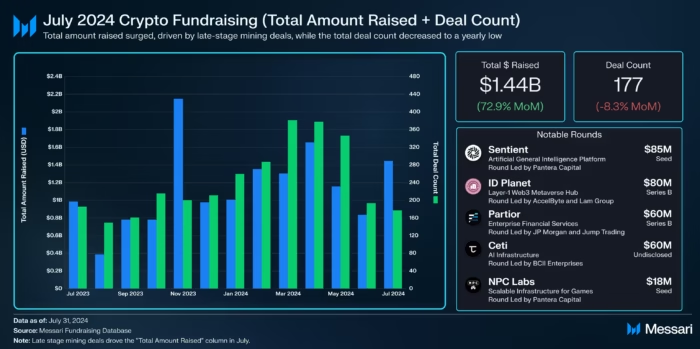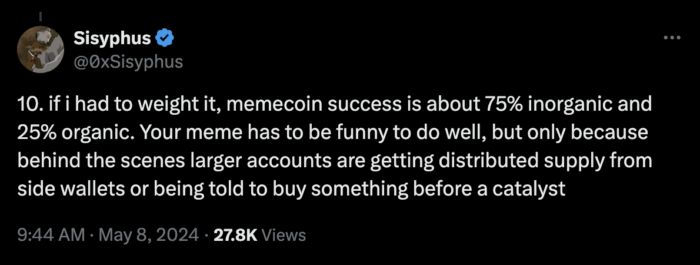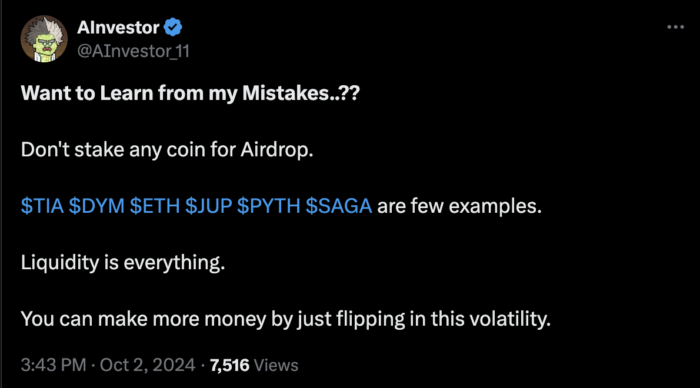“So, what’s your tokenomics?“
This likely is the most common question you’ve heard whenever you pitch to a VC when running a crypto startup. Based on the amount of funding raised in recent months (see chart below from Messari), this is indeed a multi-million-dollar question.

As someone who has been in the crypto space since 2017, I believe there are only three valid ways for tokens to accrue value. In this article, I’ll break down each of them and explain others that have been attempted but failed.
Valid Token Designs
Access
I know. Access is a broad term.
In my dictionary, an access token is defined as a token that gives its holders the right to access a resource/service, such as block spaces, rights to work for the protocol, storage, computing power, or LLMs.
Examples of this tokens category include $SOL for block space, $ETH for being a validator, $AR for permanent storage, and others.
However, the underlying resources must be highly demanded or differentiated to make this token design work. If not, then the existence of tokens as a payment method to access a resource will become a hurdle for users when using the app. We saw lots of “utility tokens“ – whatever that meant – during the ICO boom that said you could pay with it to have discounts when paying for the service. In the end, no one pays with the tokens because
- an alternative service is only a few clicks away, and
- it’s easier for retail users to use their true and trusted credit cards.
Revenue
This one is straightforward. This token type enables the holders to benefit from the values the protocol generates – via direct revenue share or token buyback.
Most US-based teams avoid this design mainly because it treats the token like a security. Issuing an instrument like this in the US could result in the issuers ending up in a Gulag or paying a huge fine.
Examples of this tokens category include $BNB with buy and burn, $TLX with a 100% revenue share, and others.
Bribe
The last one is bribe, or brib-able, to be exact. This token type is in demand because other businesses want to bribe the token holders.
Let me use Aerodrome, the largest DEX on Base, as an example.
On Aerodrome, the $AERO token holders can voluntarily lock up their tokens in exchange for more voting power – the longer the lock-up period, the more voting power you have. We will call this kind of user “stakers” from now on. Stakers can use their voting power to determine the percentage of the $AERO emission a pool will receive. If a new token issuer on Base wants to make their pool on Aerodrome more liquid, they can use their tokens as bribery to incentivize $AERO stakers to vote for their pool. As more $AERO emissions are directed to their pool, more people are willing to provide liquidity for the briber – as they can earn from the $AERO emission as the reward.
As more projects want to bribe, the bribery there should be higher as the competition heats up. Sometimes, the token issuers buy $AERO from the market and vote for themselves. Additionally, stakers on Aerodrome can earn 100% of the DEX’s transaction fees.
So, the feedback looks like this:

However, the key to making this work is the -able part.
Many protocols choose this model without considering why some businesses want to bribe the token holders. They may just believe that making the token bribeable would save their token price. But it won’t, or at least only lasts for a short time.
For a spot DEX like Aerodrome or Curve, the demand is simple—any token issuer wants to make their token liquid, as it makes the token more attractive to serious investors. But for other DeFi primitives, it’s less clear.
Invalid Token Designs
Meme Coin
In my dictionary, a meme coin is a utility-less token with a funny name.
I used to work on a dog-themed meme coin project in early 2024. Launching a meme token in 2024 is challenging and costly, and most importantly, it lacks long-term sustainability—as with most topics these days.
This thread pretty much sums up my experience working on that meme coin project. This particular tweet in that thread hits me the hardest:

Earn Ecosystem Tokens
This token design enables you to earn from future tokens within its ecosystem. For instance, staking $SNX in the early days allowed you to receive the tokens built on it, including $KWENTA, $LYRA, $THALES, and many more.
However, this type of token “utility” – if you say it’s one – is not in the meta, as most new projects launched with an insane valuation and soon nuked the token price after launch. No matter how valuable a “potential” future airdrop can be, no one will hold your tokens if it could tank 80% in 6 months, which has happened to many overly hyped projects.
I’m not alone in thinking like this:

Conclusion
The world of tokenomics is complex and often unpredictable. While these three token designs have proven more resilient and valuable than others, innovation in this space continues at a breakneck pace. New models may challenge our understanding, and seemingly obsolete designs might find new life in unexpected applications—although I doubt there would be new ones in the list.
Thanks for reading this article! I hope you learn something. See you next time.
